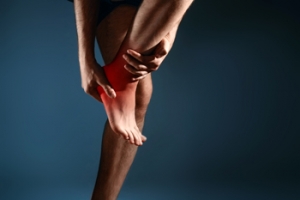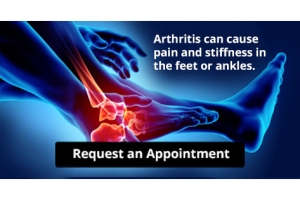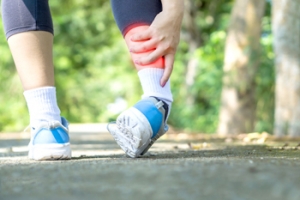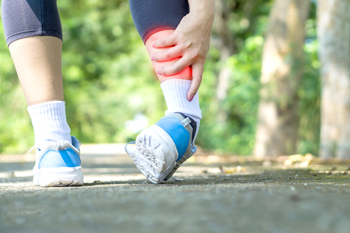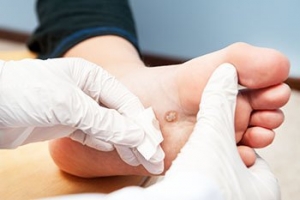
Parts of a Running Shoe
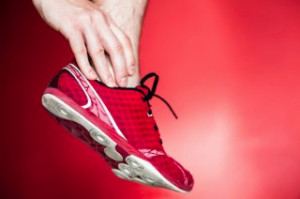 If you are a runner looking for the ideal pair of shoes that best fit your specific needs, it may help to have an understanding of the different parts of a running shoe and what they do. The “upper” is any part of the shoe above the sole. When shoe shopping, you should look for shoes with an upper that is smooth and shaped like your foot. The “ankle collar” is the wrap at the top part of the shoe opening. Its function is to hold the heel in place. You should look for an ankle collar that prevents your heel from slipping and sliding and doesn’t irritate the back of your ankle. The “toe box” encompasses the area between the laces and the front of the shoe. Look for a toe box that allows your toes to flex and spread out, without rubbing against it. To learn more about how to find the right running shoes, please consult with a podiatrist.
If you are a runner looking for the ideal pair of shoes that best fit your specific needs, it may help to have an understanding of the different parts of a running shoe and what they do. The “upper” is any part of the shoe above the sole. When shoe shopping, you should look for shoes with an upper that is smooth and shaped like your foot. The “ankle collar” is the wrap at the top part of the shoe opening. Its function is to hold the heel in place. You should look for an ankle collar that prevents your heel from slipping and sliding and doesn’t irritate the back of your ankle. The “toe box” encompasses the area between the laces and the front of the shoe. Look for a toe box that allows your toes to flex and spread out, without rubbing against it. To learn more about how to find the right running shoes, please consult with a podiatrist.
You should always make sure your running shoes fit properly in order to avoid injury. For more information, contact Dr. Robert Marcus from Foot & Ankle Center of Teaneck. Our doctor can provide the care you need to keep you pain-free and on your feet.
Choosing the Right Running Shoe for Your Foot Type
Improper shoe sizing can cause a myriad of problems for your feet. Shoes that don’t fit you properly can lead to muscular imbalances in your body, which can result in foot, knee, and hip injuries.
Tips for Finding the Right Running Shoe
- Make sure you have a thumb’s width of wiggle room between the end of your longest toe and the front of the shoe.
- There should be little to no slipping at the heel
- Don’t assume your size in one shoe brand will be your size in another
- Do not lace up your shoes too tightly
- Walk around in the store with your new shoes before you buy them
If you have any questions please feel free to contact our our office located in Teaneck, NJ . We offer the newest diagnostic and treatment technologies for all your foot and ankle needs.
Choosing the Right Running Shoe
Choosing the right running shoes for you is an important part of running. A good pair of running shoes will make the running experience more enjoyable for you and prevent potential injury.
Poorly-fitted shoes can increase the risk of injury in runners substantially. Common injuries from running with poor quality shoes include shin splints, sprained ankles, Achilles tendinitis, stress fractures, plantar fasciitis and more. This is due to the fact that bad shoes do not provide proper foot support, can increase pronation (how much the foot rolls when hitting the ground), have little to no cushioning, do not allow the feet to breath, and do not provide enough flex and rigidity in the right parts.
When looking for running shoes, first, determine where you will be running. If you are a trail runner, then pick trail shoes. If you run on concrete and asphalt, then regular running shoes are the best choice. When trying on shoes, its best to go at the end of the day as feet grow during the day and shrink after a night of sleep. Shoes should be more rigid towards the back of the foot while being more flexible up where the toes are. The toe box should provide enough room for the toes to move freely. The overall fit should be snug, not too tight but not too loose. A good pair of running shoes should also provide enough arch support for your foot type. If you experience overpronation or under-pronation while running, try to find a pair of shoes that will help correct this with different sole patterns. Finally, try to find a pair of shoes that allow the feet to breathe like nylon mesh or synthetic leather.
Don’t forget about the socks either. Socks that hold too much moisture can lead to athlete’s foot. Socks should be breathable so that your feet can air out and breathe. Synthetic socks wick away moisture like sweat. If you tend to run a lot, having a second pair of shoes that you can wear while you let the first pair air out is smart. Just don’t forget to replace your shoes after about every 300 to 500 miles.
Before you start running, it is advised to see a podiatrist to see if running is right for you. They can also offer good advice on how to run and what to look for in a pair of running shoes. If you have flat feet or poorly supported ones, they can also offer custom-made orthotics that will help give your feet the support they need.
The Podiatrist and You
 Many people endure foot and ankle injuries, pain, biomechanical problems, deformities, infections, and damage from systemic conditions that affect the lower limbs, but are hesitant to talk to their primary care doctors about it, thinking that an aching heel or a bunion has no bearing to their overall health. This is patently untrue. The feet are the foundation of the body, supporting its weight and carrying you throughout your daily life. If you have any foot or ankle problems, you should not suffer in silence. Instead, schedule an appointment with a podiatrist. Podiatrists are foot and ankle specialists who diagnose, treat, and assist patients in managing a huge variety of foot and ankle conditions. These include fractures, sprains, plantar fasciitis, bunions, hammertoes, diabetic neuropathy and foot ulcers, ingrown toenails, and much more. If you have a foot problem bothering you, consult with a podiatrist today.
Many people endure foot and ankle injuries, pain, biomechanical problems, deformities, infections, and damage from systemic conditions that affect the lower limbs, but are hesitant to talk to their primary care doctors about it, thinking that an aching heel or a bunion has no bearing to their overall health. This is patently untrue. The feet are the foundation of the body, supporting its weight and carrying you throughout your daily life. If you have any foot or ankle problems, you should not suffer in silence. Instead, schedule an appointment with a podiatrist. Podiatrists are foot and ankle specialists who diagnose, treat, and assist patients in managing a huge variety of foot and ankle conditions. These include fractures, sprains, plantar fasciitis, bunions, hammertoes, diabetic neuropathy and foot ulcers, ingrown toenails, and much more. If you have a foot problem bothering you, consult with a podiatrist today.
If you are dealing with pain in your feet and ankles, you may want to seek help from a podiatrist. Feel free to contact Dr. Robert Marcus from Foot & Ankle Center of Teaneck. Our doctor can provide the care you need to keep you pain-free and on your feet.
What Is a Podiatrist?
A podiatrist is a doctor of podiatric medicine who diagnoses and treats conditions of the foot, ankle, and related structures of the leg. Your podiatrist may specialize in a certain field such as sports medicine, wound care, pediatrics, and diabetic care. Podiatrists have the ability to become board certified through training, clinical experience, and then taking an exam.
What Do Podiatrists Do?
On a daily basis, a podiatrist may perform the following activities:
- Diagnose foot ailments such as ulcers, tumors, fractures, etc.
- Use innovative methods to treat conditions
- Use corrective orthotics, casts, and strappings to correct deformities
- Correct walking patterns and balance
- Provide individual consultations to patients
It is very important that you take care of your feet. It’s easy to take having healthy feet for granted, however foot problems tend to be among the most common health conditions. Podiatrists can help diagnose and treat a variety of feet related conditions, so it is crucial that you visit one if you need assistance.
If you have any questions please feel free to contact our office located in Teaneck, NJ . We offer the newest diagnostic and treatment technologies for all your foot and ankle needs.
What is a Podiatrist?
A podiatrist is a Doctor of Podiatric Medicine who treats the foot, ankle, and related structures of the leg. If you are having any pain, injuries, or abnormalities in these areas, it is best that you seek help from a podiatrist.
Podiatrists complete four years of training in a podiatric medical school. Their training is like that of other physicians, and they may go on to complete a fellowship training after a residency training. Some podiatrists are board certified meaning they have advanced training, clinical experience, and have taken an exam to prove their skills. Certifying boards for podiatry are the American Board of Foot and Ankle Surgery and the American Board of Podiatric Medicine. Podiatrists may work in private practices, hospitals, clinics, or they may even become professors at colleges of podiatric medicine.
While in college, those who want to be podiatrists often take biology, chemistry, and physics classes in preparation for podiatry school. In podiatry school, students study how the bones, nerves, and muscles work together to help you move around. Additionally, they study injuries and how to properly diagnose and treat them. Admittance into podiatric medical school requires the completion of 90 semester hours of undergraduate study with a good grade point average, and acceptable scores on the MCAT (Medical College Admission Test)
Podiatrists treat many different conditions such as: aching feet, ankle pain, bunions, corns, hammertoes, fungus, ingrown toenails, plantar fasciitis, sprains and more. Common forms of treatment for these conditions are physical therapy, drugs, or surgery. Podiatrists may also recommend corrective shoe inserts, custom-made shoes, plaster casts, and strappings to correct deformities.
Even if you are someone whose feet are in generally good condition, you should still visit a podiatrist to have your feet properly exfoliated and maintained, or to make sure you are looking after your feet properly.
Why Does the Side of My Foot Hurt?
 There are many reasons why the side of your foot may be in pain. Often, seemingly minor injuries, like a stress fracture in one of the bones of the foot or ankle, can produce pain on the side of the foot. Ankle sprains, cuboid syndrome, and peroneal tendonitis can occur due to damage to the ligaments, bones, or tendons of the feet and ankles, respectively. Deformities and skin conditions, such as bunions, corns, and calluses may also be to blame. A congenital condition called tarsal coalition can result in foot pain, fatigue, flat feet, and a dysfunctional gait. Arthritis, both rheumatoid and osteoarthritis, is also a potential cause of foot pain. If you have pain on the side of your foot, don’t wait for it to go away on its own, as untreated pain can often become chronic. Instead, seek the care of a podiatrist, who can diagnose and treat your condition.
There are many reasons why the side of your foot may be in pain. Often, seemingly minor injuries, like a stress fracture in one of the bones of the foot or ankle, can produce pain on the side of the foot. Ankle sprains, cuboid syndrome, and peroneal tendonitis can occur due to damage to the ligaments, bones, or tendons of the feet and ankles, respectively. Deformities and skin conditions, such as bunions, corns, and calluses may also be to blame. A congenital condition called tarsal coalition can result in foot pain, fatigue, flat feet, and a dysfunctional gait. Arthritis, both rheumatoid and osteoarthritis, is also a potential cause of foot pain. If you have pain on the side of your foot, don’t wait for it to go away on its own, as untreated pain can often become chronic. Instead, seek the care of a podiatrist, who can diagnose and treat your condition.
Foot Pain
Foot pain can be extremely painful and debilitating. If you have a foot pain, consult with Dr. Robert Marcus from Foot & Ankle Center of Teaneck. Our doctor will assess your condition and provide you with quality foot and ankle treatment.
Causes
Foot pain is a very broad condition that could be caused by one or more ailments. The most common include:
- Bunions
- Hammertoes
- Plantar Fasciitis
- Bone Spurs
- Corns
- Tarsal Tunnel Syndrome
- Ingrown Toenails
- Arthritis (such as Gout, Rheumatoid, and Osteoarthritis)
- Flat Feet
- Injury (from stress fractures, broken toe, foot, ankle, Achilles tendon ruptures, and sprains)
- And more
Diagnosis
To figure out the cause of foot pain, podiatrists utilize several different methods. This can range from simple visual inspections and sensation tests to X-rays and MRI scans. Prior medical history, family medical history, and any recent physical traumatic events will all be taken into consideration for a proper diagnosis.
Treatment
Treatment depends upon the cause of the foot pain. Whether it is resting, staying off the foot, or having surgery; podiatrists have a number of treatment options available for foot pain.
If you have any questions, please feel free to contact our office located in Teaneck, NJ . We offer the newest diagnostic and treatment technologies for all your foot care needs.
Foot Pain
The feet, being the foundation of the body, carry all of the body’s weight and are therefore prone to experiencing pain and discomfort. If you are experiencing foot pain, it is important to determine where in the foot you are experiencing this pain to help discover the cause of it. While pain can be experienced virtually anywhere in the foot, the most common sites of foot pain are in the heel and ankle.
Heel pain can be due to a multitude of conditions including plantar fasciitis, Achilles tendinitis, and heel spurs. Pain experienced in the ankle can be a sign of an ankle sprain, arthritis, gout, ankle instability, ankle fracture, or nerve compression. In more serious cases, pain in the foot can be a sign of improper alignment or an infection.
Foot pain can be accompanied by symptoms including redness, swelling, stiffness and warmth in the affected area. Whether the pain can be described as sharp or dull depends on the foot condition behind it. It is important to visit your local podiatrist if your foot pain and its accompanying symptoms persist and do not improve over time.
Depending on the location and condition of your foot pain, your podiatrist may prescribe certain treatments. These treatments can include but are not limited to prescription or over-the-counter drugs and medications, certain therapies, cortisone injections, or surgery.
If you are experiencing persistent foot pain, it is important to consult with your foot and ankle doctor to determine the cause and location. He or she will then prescribe the best treatment for you. While milder cases of foot pain may respond well to rest and at-home treatments, more serious cases may take some time to fully recover.
Arthritis Can Cause Pain in the Feet and Ankles
Practical Tips for Preventing Running Injuries
As a runner, taking good care of your feet can help you perform at peak levels while reducing your risks of injury. First and foremost, choose the right running shoes. Get fitted by a professional, and take into consideration your style of running, fitness goals, and the type of terrain you’ll be running on. Get your feet used to new shoes by wearing them around the house first. Wear moisture-wicking socks to keep feet dry and to avoid athlete’s foot and blisters—which can also be prevented by applying petroleum jelly or body glide on areas of friction. Reduce swelling and help your feet and muscles recover by icing and massaging your feet. Keep your toenails trimmed at the right length and straight across to avoid bruised or ingrown toenails. Do strengthening exercises to build up muscles in your feet. For more tips on avoiding running injuries, strengthening foot muscles, and choosing the right shoe for your feet, consult with a podiatrist.
Exercising your feet regularly with the proper foot wear is a great way to prevent injuries. If you have any concerns about your feet, contact Dr. Robert Marcus of Foot & Ankle Center of Teaneck. Our doctor will treat your foot and ankle needs.
How to Prevent Running Injuries
Many common running injuries are caused by overuse and overtraining. When the back of the kneecap starts wearing out and starts causing pain in your knee, this is commonly referred to as runner’s knee. Runner’s knee is a decrease in strength in your quadriceps and can occur if you’re not wearing properly fitted or supporting shoes. To prevent runner’s knee, focusing on hip strengthening is a good idea, as well as strengthening your quads to keep the kneecaps aligned.
What Are Some Causes of Running Injuries?
- One cause of a common running injury is called iliotibial band syndrome.
- Plantar fasciitis is also another common injury.
- Stress fractures can occur from overtraining, lack of calcium, or even your running style.
Best Ways to Prevent Running Injuries
- Wear footwear that fits properly and suits your running needs.
- Running shoes are the only protective gear that runners have to safeguard them from injury.
- Make a training schedule. Adding strengthening exercises as well as regular stretching can help keep you strong and limber and can lessen the possibility of injuries.
- Stretching keeps muscles limber; this will help you gain better flexibility.
If you have any questions please feel free to contact our office located in Teaneck, NJ . We offer the newest diagnostic and treatment technologies for all your foot and ankle needs.
How to Prevent Running Injuries
Overtraining and overusing the feet are the main causes of common running injuries. A number of these common injuries are caused by overrunning. Runner’s knee is a condition that is characterized by the back of the kneecap beginning to wear away and cause pain in the knee. This frequently occurs due to either a decrease in strength in the quadriceps muscles or ill-fitting shoes that are lacking in proper support for the inside of the forefoot. Strengthening exercises focusing on the quad muscle and sports orthotics are the usual treatments for those suffering from runner’s knee. Prevention of the condition lies in a focus on hip strengthening and quad-strengthening to keep the kneecap aligned. To help learn the best exercise to heal runner’s knee, one can also undergo physical therapy.
One common injury, called iliotibial band syndrome, is often caused by overtraining. This condition occurs when the iliotibial band gets irritated, creating pain and discomfort in the outside knee area. Plantar fasciitis, another common running injury, also occurs as a result of inflammation and irritation. Plantar fasciitis is an inflammation and irritation of the bone in the foot. A large amount of pain is often experienced due to plantar fasciitis. The condition can be caused by a high arch, improper footwear, tight muscles, or flat feet. It can best be avoided by stretching and wearing appropriate footwear that supports the foot.
Another common injury for runners is stress fractures. These injuries occur due to running style, overtraining, or a lack of calcium. Stress fractures most often occur in several locations in runners, including the inner bone of the leg, the thighbone, the bone at the base of the spine and the bones of the toes. Stress fractures are best prevented by wearing proper footwear and by running on flat and hard surfaces; this will absorb some of the shock created during running.
Aside from overtraining, other causes of common running injuries include ill-fitting footwear, a lack of flexibility and strength, and irregular biomechanics. The best way to avoid running injuries is to prevent them from even occurring. Both iliotibial band syndrome and stress fractures are preventable. The first step that should be taken to prevent running injuries is to only wear footwear that fits properly and that is appropriate for whatever activity you are doing. Running shoes are the only protective gear available to runners that can safeguard them from sustaining injuries. Choosing the right pair of shoes is therefore extremely important. While running shoes are an important factor, it is also important to consider other facets of your running routine such as training schedules, flexibility, and strengthening. These elements should be considered and altered according to your running needs to best maximize your run and minimize the possibility of injury. Careful stretching before and after a run should also be considered to help prevent running injuries. Stretching muscles enables greater flexibility and a lesser chance of sustaining injury.
An Overview of Plantar Warts
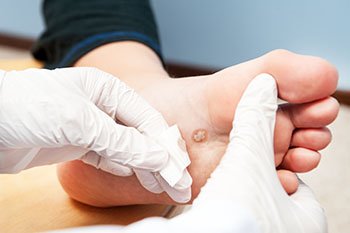 Plantar warts are benign skin growths that occur on the soles of the feet due to a human papillomavirus (HPV) infection. HPV can get into the feet through a tiny crack in the skin and make the top layer of skin grow rapidly, thereby creating a wart. Warts on the bottom of the feet may be asymptomatic, or they may cause pain or discomfort while standing or walking due to pressure on the bottom of the foot. Plantar warts can typically be diagnosed through a physical examination and can be treated through medications, cryotherapy, or surgical removal. If you have plantar warts, consult with a podiatrist to find the right treatment for you.
Plantar warts are benign skin growths that occur on the soles of the feet due to a human papillomavirus (HPV) infection. HPV can get into the feet through a tiny crack in the skin and make the top layer of skin grow rapidly, thereby creating a wart. Warts on the bottom of the feet may be asymptomatic, or they may cause pain or discomfort while standing or walking due to pressure on the bottom of the foot. Plantar warts can typically be diagnosed through a physical examination and can be treated through medications, cryotherapy, or surgical removal. If you have plantar warts, consult with a podiatrist to find the right treatment for you.
Plantar warts can be very uncomfortable. If you need your feet checked, contact Dr. Robert Marcus from Foot & Ankle Center of Teaneck. Our doctor will assist you with all of your foot and ankle needs.
About Plantar Warts
Plantar warts are the result of HPV, or human papillomavirus, getting into open wounds on the feet. They are mostly found on the heels or balls of the feet.
While plantar warts are generally harmless, those experiencing excessive pain or those suffering from diabetes or a compromised immune system require immediate medical care. Plantar warts are easily diagnosed, usually through scraping off a bit of rough skin or by getting a biopsy.
Symptoms
- Lesions on the bottom of your feet, usually rough and grainy
- Hard or thick callused spots
- Wart seeds, which are small clotted blood vessels that look like little black spots
- Pain, discomfort, or tenderness of your feet when walking or standing
Treatment
- Freezing
- Electric tool removal
- Laser Treatment
- Topical Creams (prescription only)
- Over-the-counter medications
To help prevent developing plantar warts, avoid walking barefoot over abrasive surfaces that can cause cuts or wounds for HPV to get into. Avoiding direct contact with other warts, as well as not picking or rubbing existing warts, can help prevent the further spread of plantar warts. However, if you think you have developed plantar warts, speak to your podiatrist. He or she can diagnose the warts on your feet and recommend the appropriate treatment options.
If you have any questions please feel free to contact our office located in Teaneck, NJ . We offer the newest diagnostic and treatment technologies for all your foot and ankle needs.





